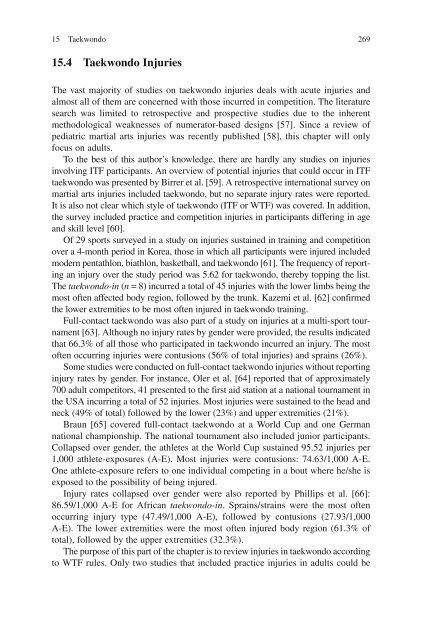Nutrition in Combat Sports
Nutrition in Combat Sports
Nutrition in Combat Sports
You also want an ePaper? Increase the reach of your titles
YUMPU automatically turns print PDFs into web optimized ePapers that Google loves.
15 Taekwondo 269<br />
15.4 Taekwondo Injuries<br />
The vast majority of studies on taekwondo <strong>in</strong>juries deals with acute <strong>in</strong>juries and<br />
almost all of them are concerned with those <strong>in</strong>curred <strong>in</strong> competition. The literature<br />
search was limited to retrospective and prospective studies due to the <strong>in</strong>herent<br />
methodological weaknesses of numerator-based designs [57] . S<strong>in</strong>ce a review of<br />
pediatric martial arts <strong>in</strong>juries was recently published [58] , this chapter will only<br />
focus on adults.<br />
To the best of this author’s knowledge, there are hardly any studies on <strong>in</strong>juries<br />
<strong>in</strong>volv<strong>in</strong>g ITF participants. An overview of potential <strong>in</strong>juries that could occur <strong>in</strong> ITF<br />
taekwondo was presented by Birrer et al. [59] . A retrospective <strong>in</strong>ternational survey on<br />
martial arts <strong>in</strong>juries <strong>in</strong>cluded taekwondo, but no separate <strong>in</strong>jury rates were reported.<br />
It is also not clear which style of taekwondo (ITF or WTF) was covered. In addition,<br />
the survey <strong>in</strong>cluded practice and competition <strong>in</strong>juries <strong>in</strong> participants differ<strong>in</strong>g <strong>in</strong> age<br />
and skill level [60] .<br />
Of 29 sports surveyed <strong>in</strong> a study on <strong>in</strong>juries susta<strong>in</strong>ed <strong>in</strong> tra<strong>in</strong><strong>in</strong>g and competition<br />
over a 4-month period <strong>in</strong> Korea, those <strong>in</strong> which all participants were <strong>in</strong>jured <strong>in</strong>cluded<br />
modern pentathlon, biathlon, basketball, and taekwondo [61] . The frequency of report<strong>in</strong>g<br />
an <strong>in</strong>jury over the study period was 5.62 for taekwondo, thereby topp<strong>in</strong>g the list.<br />
The taekwondo-<strong>in</strong> ( n = 8) <strong>in</strong>curred a total of 45 <strong>in</strong>juries with the lower limbs be<strong>in</strong>g the<br />
most often affected body region, followed by the trunk. Kazemi et al. [62] confirmed<br />
the lower extremities to be most often <strong>in</strong>jured <strong>in</strong> taekwondo tra<strong>in</strong><strong>in</strong>g.<br />
Full-contact taekwondo was also part of a study on <strong>in</strong>juries at a multi-sport tournament<br />
[63] . Although no <strong>in</strong>jury rates by gender were provided, the results <strong>in</strong>dicated<br />
that 66.3% of all those who participated <strong>in</strong> taekwondo <strong>in</strong>curred an <strong>in</strong>jury. The most<br />
often occurr<strong>in</strong>g <strong>in</strong>juries were contusions (56% of total <strong>in</strong>juries) and spra<strong>in</strong>s (26%).<br />
Some studies were conducted on full-contact taekwondo <strong>in</strong>juries without report<strong>in</strong>g<br />
<strong>in</strong>jury rates by gender. For <strong>in</strong>stance, Oler et al. [64] reported that of approximately<br />
700 adult competitors, 41 presented to the first aid station at a national tournament <strong>in</strong><br />
the USA <strong>in</strong>curr<strong>in</strong>g a total of 52 <strong>in</strong>juries. Most <strong>in</strong>juries were susta<strong>in</strong>ed to the head and<br />
neck (49% of total) followed by the lower (23%) and upper extremities (21%).<br />
Braun [65] covered full-contact taekwondo at a World Cup and one German<br />
national championship. The national tournament also <strong>in</strong>cluded junior participants.<br />
Collapsed over gender, the athletes at the World Cup susta<strong>in</strong>ed 95.52 <strong>in</strong>juries per<br />
1,000 athlete-exposures (A-E). Most <strong>in</strong>juries were contusions: 74.63/1,000 A-E.<br />
One athlete-exposure refers to one <strong>in</strong>dividual compet<strong>in</strong>g <strong>in</strong> a bout where he/she is<br />
exposed to the possibility of be<strong>in</strong>g <strong>in</strong>jured.<br />
Injury rates collapsed over gender were also reported by Phillips et al. [66] :<br />
86.59/1,000 A-E for African taekwondo-<strong>in</strong> . Spra<strong>in</strong>s/stra<strong>in</strong>s were the most often<br />
occurr<strong>in</strong>g <strong>in</strong>jury type (47.49/1,000 A-E), followed by contusions (27.93/1,000<br />
A-E). The lower extremities were the most often <strong>in</strong>jured body region (61.3% of<br />
total), followed by the upper extremities (32.3%).<br />
The purpose of this part of the chapter is to review <strong>in</strong>juries <strong>in</strong> taekwondo accord<strong>in</strong>g<br />
to WTF rules. Only two studies that <strong>in</strong>cluded practice <strong>in</strong>juries <strong>in</strong> adults could be

















